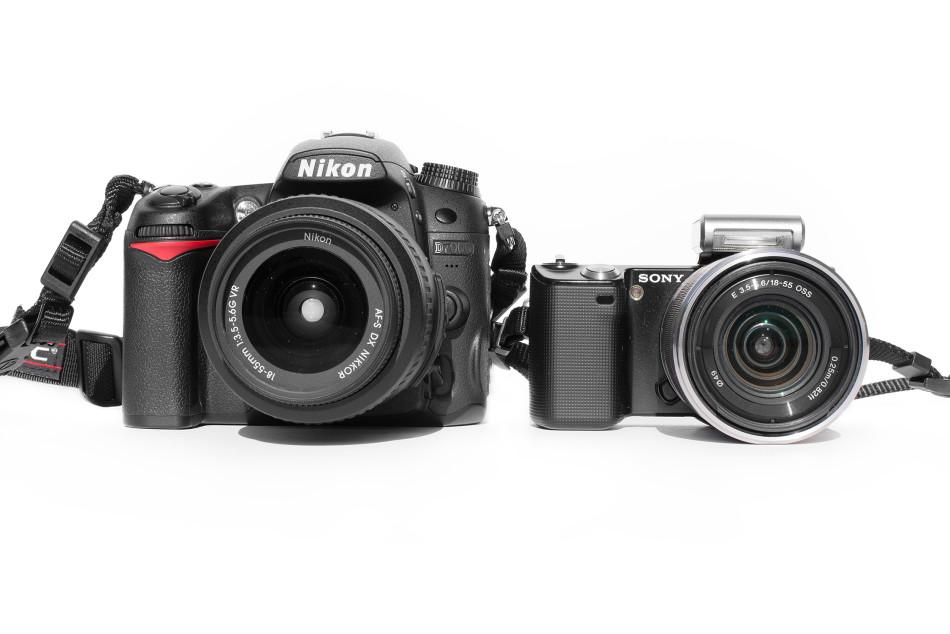Shaynanigans: DSLRs are obsolete, and no, not because of iPhones
Despite the DSLR on the left being much larger and double the price, you’d be wrong if you thought it yields higher quality images than the mirrorless camera on the right. Each camera has their respective manufacturer’s 18-55mm f/3.5-f/5.6 standard zoom lens mounted.
Maybe you just purchased a brand new DSLR. You selected a fast, sharp lens to accompany it. If anything I just said excited you the way a new iPhone might excite a normal teenager, you might call yourself a photographer. Well, I don’t want to disappoint, but you might want to reconsider your purchase.
I’ve been taking photos for about four years now. But I purchased my first DSLR only recently. Why, you may ask, did I not take a DSLR into consideration earlier?
I’ve shot with a Sony NEX-5 since I was in middle school. It features most of the advantages of a DSLR: a mechanical shutter, 14-bit RAW, and most importantly, a fully fledged manual mode and an APS-C sensor equivalent to or better than most Nikon DX sensors of the time. The difference is, it has no viewfinder or mirror.
What this all meant was, I got supposedly “DSLR-quality” images all with a camera that, without a lens mounted, fit in my pocket, all for half the price of a Canon EOS 7D or a Nikon D7000. People wouldn’t even consider for a mere moment that my photographs weren’t shot with a DSLR (and I didn’t bother to correct them).
How that is possible? Allow me to elucidate.
Back in the era of film cameras, a viewfinder was necessary for composition purposes; there was no other way to see what was being photographed. But if the light from the lens is directed onto the film, how is it possible for the viewfinder to work? The answer is simple.
The mirror in an SLR facilitates all your compositional needs. When the mirror is down, it directs light (using something called a pentaprism) into the viewfinder. When the shutter button is pressed, the mirror flips up, and, (to put it in technical terms) gets out of the way. The light then reaches the film instead of the viewfinder and exposes the photograph.
Fast forward to the 21st century, however, and we now have “digital film” (a sensor). Unlike film, a video feed from the sensor can be viewed electronically in real time. An LCD can display this video feed and serves the purpose of the viewfinder; no mirror needed. The lens mount can now be placed nearer to the sensor; enabling the whole camera body to be much smaller.
Would having your camera’s screen on continuously have repercussions for battery life? Yes, the backlight of a screen siphons out quite a significant amount of energy from your battery, possibly more than anything else on a camera.
Well, there’s also something that’s been around for a while called an EVF (electronic viewfinder). It’s a tiny screen nestled in the area where the viewfinder used to be. The screen backlight doesn’t have to be nearly as bright for such a tiny area, therefore the power draw is insignificant (and it appeals to those clinging to the past). So that problem is solved.
Mirrors are vestigial, useless elements of the camera; only existing as archaic remnants of the last century. Mirrorless cameras are the future. Their manufacturers (Sony, in particular) are focused on the design and the user experience as well; much as Apple used to be. They’re not annually producing minutely improved iterations of (and let’s all admit it) ugly, uninspired, misshapen black boxes. Sony’s cameras are beautifully designed, and their lenses are equally aesthetic. Worried about image quality from a Sony not matching one from the big two (Canon/Nikon)? Get this: the Nikon D600 and D800/E have Sony sensors.
I don’t really understand why SLRs even exist anymore. The contrast detection autofocus of mirrorless systems is steadily improving. DSLRs even have live preview, which is where the camera likes to pretend it’s a mirrorless and keeps the mirror up. You view what you’re photographing on the screen for composition purposes.
Yes, there were drawbacks to my consumer level Sony NEX-5. The 18-55 f/3.5-f/5.6 kit lens was not so sharp at anything but f/8, the autofocus was not professional grade or customizable, and there were and still are far fewer Sony E mount lenses available than Canon EF- or Nikon F-mount lenses. So what? I had one lens. I just took photos and didn’t care.
Now, as most pro cameras with better sensors happen to be DSLRs and therefore have an analog viewfinder and mirror (that aren’t necessary), I finally went ahead and upgraded to a DSLR.
Then Sony released the mirrorless a7 and a7r, which have full-frame, pro-caliber sensors. To be more precise, the same sensors licensed to Nikon for their FX cameras. They’re also much cheaper (by about $400-$500), are much smaller, and are much better at video for reasons I won’t get into. Having just missed the first wave of professional-quality mirrorless cameras, I feel like I just got slapped in the face. And Nikon’s current full-frame cameras are exceptionally capable.
My old mirrorless camera has survived all the abuse it has been put through, from shooting in rougher areas of San Jose to ski runs, all while being reasonably discreet. I am pleased by the performance of my SLR, but it doesn’t feel as innovative or as well-designed as the Sony, nor is it nearly as inconspicuous.
In today’s age, where every other area of the technology industry seems to brimming with ingenuity and innovation, Nikon and Canon have led the camera industry to an almost pathetic level of stagnation. I don’t want to see a D7200 or a 5D Mark IV; what we need is something truly revolutionary. With the a7/r, the underdog finally got it right.

Shay Lari-Hosain (12) is the Editor-in-Chief and co-founder of Wingspan Magazine. Shay has interviewed 2013 Nobel Laureates, authors like Khaled Hosseini...


















![“[Building nerf blasters] became this outlet of creativity for me that hasn't been matched by anything else. The process [of] making a build complete to your desire is such a painstakingly difficult process, but I've had to learn from [the skills needed from] soldering to proper painting. There's so many different options for everything, if you think about it, it exists. The best part is [that] if it doesn't exist, you can build it yourself," Ishaan Parate said.](https://harkeraquila.com/wp-content/uploads/2022/08/DSC_8149-900x604.jpg)




![“When I came into high school, I was ready to be a follower. But DECA was a game changer for me. It helped me overcome my fear of public speaking, and it's played such a major role in who I've become today. To be able to successfully lead a chapter of 150 students, an officer team and be one of the upperclassmen I once really admired is something I'm [really] proud of,” Anvitha Tummala ('21) said.](https://harkeraquila.com/wp-content/uploads/2021/07/Screen-Shot-2021-07-25-at-9.50.05-AM-900x594.png)







![“I think getting up in the morning and having a sense of purpose [is exciting]. I think without a certain amount of drive, life is kind of obsolete and mundane, and I think having that every single day is what makes each day unique and kind of makes life exciting,” Neymika Jain (12) said.](https://harkeraquila.com/wp-content/uploads/2017/06/Screen-Shot-2017-06-03-at-4.54.16-PM.png)








![“My slogan is ‘slow feet, don’t eat, and I’m hungry.’ You need to run fast to get where you are–you aren't going to get those championships if you aren't fast,” Angel Cervantes (12) said. “I want to do well in school on my tests and in track and win championships for my team. I live by that, [and] I can do that anywhere: in the classroom or on the field.”](https://harkeraquila.com/wp-content/uploads/2018/06/DSC5146-900x601.jpg)
![“[Volleyball has] taught me how to fall correctly, and another thing it taught is that you don’t have to be the best at something to be good at it. If you just hit the ball in a smart way, then it still scores points and you’re good at it. You could be a background player and still make a much bigger impact on the team than you would think,” Anya Gert (’20) said.](https://harkeraquila.com/wp-content/uploads/2020/06/AnnaGert_JinTuan_HoHPhotoEdited-600x900.jpeg)

![“I'm not nearly there yet, but [my confidence has] definitely been getting better since I was pretty shy and timid coming into Harker my freshman year. I know that there's a lot of people that are really confident in what they do, and I really admire them. Everyone's so driven and that has really pushed me to kind of try to find my own place in high school and be more confident,” Alyssa Huang (’20) said.](https://harkeraquila.com/wp-content/uploads/2020/06/AlyssaHuang_EmilyChen_HoHPhoto-900x749.jpeg)



